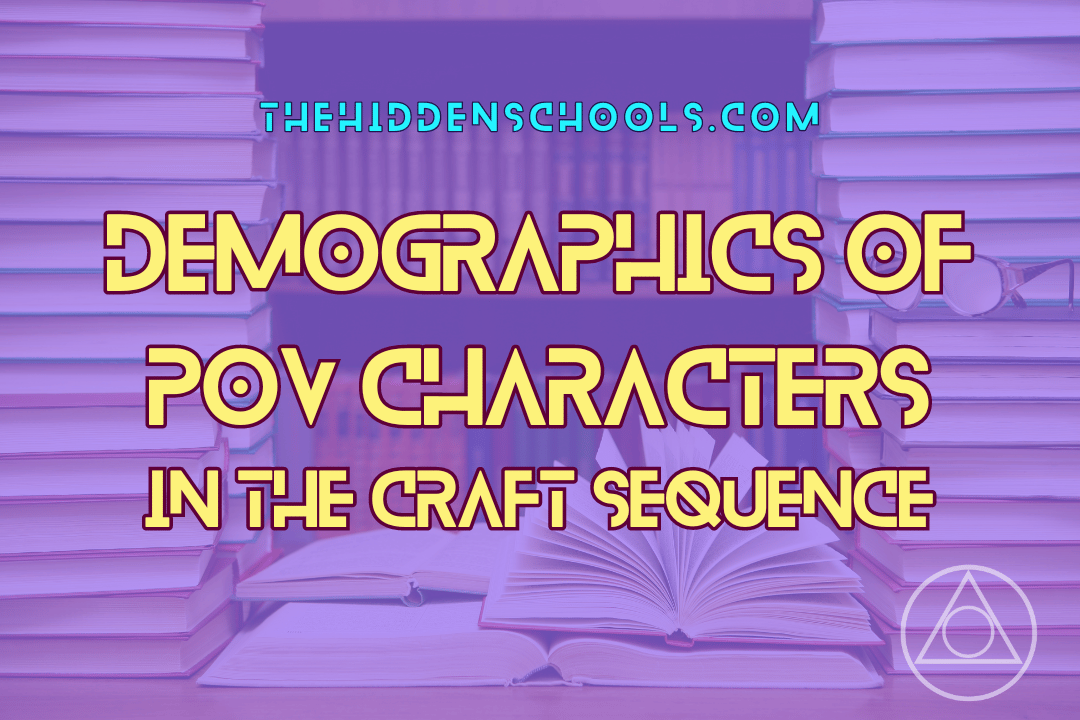Who is Tara Abernathy? | Craft Sequence Character Deep Dive
“When the Hidden Schools threw Tara Abernathy out, she fell a thousand feet through wisps of cloud and woke to find herself alive, broken and bleeding, beside the Crack in the World.”
Is this one of the best character introductions of recent years? Yes, yes it is. Is it one of the best character introductions ever? I would argue that yes, it is indeed.
This is how we meet Tara Abernathy, the protagonist of three out of six Craft Sequence novels – including the first published book, Three Parts Dead, and the most recent book, Dead Country, which also serves as an entry point for new readers. It’s likely, therefore, that Tara is the first main character readers will experience in the series. That’s why we’re doing our first character deep dive series focused on Tara – that, and because she’s our favourite. Elayne Kevarian comes a close second; but as you’ll see in a later entry to this series, the two of them are closely linked both thematically and as characters.
In this article we’re going to look at the basics of who Tara is and her arc across the series so far, but in more depth than the brief who’s who post from a couple of years back. Future instalments will focus on her childhood, her relationships, particular experiences in the books, and where she’s likely to go in the remaining two books of the Craft Wars trilogy.
In case it isn’t obvious, this post and all future Tara Abernath Deep Dive posts contain major spoilers for the series. You have been warned.
What does Tara Abernathy look like?
Before we jump into personality and other intangibles, let’s get situated with visualising Tara.
We have quite clear descriptions of Tara’s appearance, and the images of her on the cover of Three Parts Dead and Four Roads Cross more or less correlate with these descriptions – despite the two women on the covers clearly being drawn from very different references as they look nothing alike. Tara is also featured in a different illustrative style on the newest cover, Wicked Problems.
I’m not a huge fan of imagining characters based on cover images as we know they can be wildly divergent - how many times have you heard of characters of colour been depicted as white or at least white passing on covers? It’s even happened in the Craft Sequence, with Caleb and Temoc both being described as dark skinned but being depicted on their respective covers as very fair. However, the Tara illustrations look relatively accurate to her descriptions.
“We’re looking for the young lady who gave you those scars. Dark skin, five-seven, curly black hair, curvy, freckles. Last seen surrounded by a halo of flame?”
“....the stand Tara never visited because their father assumed she was foreign and talked to her loud and slow as if she were the only dark-skinned woman in Alt Coulumb...”
“The shadow failed and a Craftswoman emerged: dark skinned with curly black hair, glyphs shining on her arms, wearing a glower and a charcoal suit.”
So there we have it: Tara is dark skinned with curly hair, and while racial categories are a bit different in the Craft Sequence world than our own, she is depicted as a Black North American woman. She’s mid height (actually quite short for women in the Craft Sequence, many of whom are described as hitting nearly 6ft). She’s curvy, and though that can mean very different things to different people it seems to me that the book cover depictions aren’t quite accurate here. On that point, dark skin can also mean quite different things to different people, so let your imagination run wild.
What is Tara Abernathy like as a person?
Tara is a Craftswoman, which for the uninitiated means witch-necromancer-lawyer. Though if you’re uninitiated, this article is not the place to start so you should check out this Beginner’s Guide instead. As seen in the quote above, Tara graduates from the Hidden Schools in the first paragraph in which we meet her, and we follow the first few years of her career and her struggles with ethics and morality in the complex web of systems that keep the modern world running.
Tara comes from a small middle of nowhere town called Edgemont, where she never really fit in. Although her father was a local, her mother was a refugee from Alt Selene, a victim of the God Wars finding safety in the rural nothingness of Edgemont. Her hometown is on the edge of the Badlands, a swath of desolate countryside – we see a lot of Edgemont and the Badlands in Dead Country, and discover the magical secrets hidden in this seemingly dead country. Which is, obviously, where the book title comes from.
She left the town as soon as she could and joined caravans crossing Northern Kath, a continent analogous to North America. Tara had discovered her natural aptitude for the Craft as a young child, and spent her nomadic years learning whatever she could from anyone willing to teach her. From there, she went to the Hidden Schools, a floating magical university.
“I took a job on the next merchant’s caravan that came through town, and wandered with them for a few years, learning everything I could from their lesser Craftsmen, fighting Raiders, keeping the scorpionkind at bay. One night after the campfire died, I sat naked on the sand, soaking in the starlight I would need for the next day’s Craft, and I looked up and saw the Hidden Schools: towers rising out of midair and plummeting into empty space, castles with parapets on both ends, hovering globes of glass and crystal the size of the Third Court of Craft.
“I was terrified. I had been calling the schools to me for months, as any young Craftswoman who wants to study there will do, but they never answered before.
“I’d tell you about the rainbow bridge that descended from the twelve-spired Elder Hall, a building so old it became new again, to offer me entrance; I’d tell you about the challenges I faced as I climbed that rainbow, of might and Craft and cunning; I’d tell you about being welcomed into the Hidden Schools as they cloaked themselves in clouds that were not clouds. But none of these things are important to my story.”
Tara was always determined and driven, stubborn and sharp. She knew what she wanted – to become a Craftswoman – and she would do whatever necessary to reach that goal. But, during her studies, she learned the bad side of that ambition and the power the Craft gives people, the way it teaches you to play with other people’s lives like chess pieces. When she sees it hurt someone she loves, she attempts to burn out the damage and in turn is thrown from the Hidden Schools.
How does Tara Abernathy develop over the series so far?
Despite everything, at the begininng of Three Parts Dead she still believes in the system as a whole. Over the course of the series, this belief is battered time and time again until we reach Dead Country and her first opportunity to mentor and teach an aspiring Craftswoman from a similar background as her own. By this point, Tara has been faced with moral quandary after moral quandary, made mistakes and deals, and come out the other side with a better sense of herself and what she’s willing to compromise and what she isn’t. Where we end the series so far, Tara no longer believes in the system. In fact, she’s more or less fighting against it.
“She had left [Edgemont] an eager angry witch-girl, drunk on sweet hope and intimations of power that would have soured if she stayed. She had returned a sorceress and a shell, betrayed by her teachers and by the world of Craft she’d hoped to master. They used her and cast her out, but she refused to die.”
Tara Abernathy, drawn by my friend Lili - I’ll link her social media if and when she sets it up. Thank you Lili!!!
Throughout the series, Tara moves further and further away from the world of the Craft, making friends and allies across ‘enemy’ lines. When she first meets Abelard, a priest in the Church of Kos, she is dismissive of him, his faith, his abilities and ultimately him as a person. She notes that had their meeting taken place a few decades earlier, it would have been on opposite sides of a battlefield – whilst that isn’t their current position, it’s clear that she still views him through that lens. He and his church may be her clients in the Three Parts Dead case, but she views them with suspicion. By the end of the book, they are not only allies but becoming friends and colleagues; Tara turns down the opportunity to continue on her path in one of the world’s foremost Craft firms to become in-house counsel for the Church of Kos. We see a lovely development of the Tara and Abelard friendship in short story Man in the Middle, which takes place directly after Three Parts Dead, showing Tara’s innate suspicion to Abelard and the priesthood, but the first cracks in her armour.
Across the series, Tara becomes a reluctant priestess to a goddess, the antithesis of everything Craftsfolk stand for. Her friends and allies aren’t other Craftspeople but priests and priestesses, gargoyles dedicated to the worship of a goddess, a tree hugging social enterprise kind of organisation that works to bridge the gap between gods and the Craft. In Ruin of Angels she goes against her contracted allies, the Iskari, to stand alongside a grassroots goddess and her people, the disenfranchised and unwanted of Agdel Lex.
Yet she is still firmly a Craftswoman. She is the boogie monster for her old neighbours when she returns in Dead Country, terrifying them with power they can’t understand. Tara remains more comfortable in dealing with stars and souls and necromancy than the ‘normal’ people she grew up around. But the Tara of Dead Country is more willing to learn. More able to compromise. More likely to understand the perspectives of those she disagrees with. She is able to save Edgemont, fight the Raiders, and discover a dark secret at the heart of the Badlands because of her experiences and new perspectives. The Tara of Three Parts Dead’s opening scene would not have been able to do what Dead Country Tara was able to – and, more importantly, willing to do.
“That’s the trade you make when you learn the Craft, a trade no on in the Hidden Schools will ever tell you about save with whispers about students who strayed too far and fell: you trade compliance for power. You have strength so long as you use that strength to stay inside the lines. But the world’s broken, and its lines are cuts through flesh. You know that, and I know that. So we do what we can.”
Next time we’ll be looking at Tara’s childhood and upbringing, and how that made her into the character we know today. Subscribe to be the first to get new posts and sneak peeks!
What do you think? Let me know in the comments, on Twitter or on r/CraftSequence. And don’t forget you can subscribe to be the first to hear about new articles and fun projects in the pipeline.





















